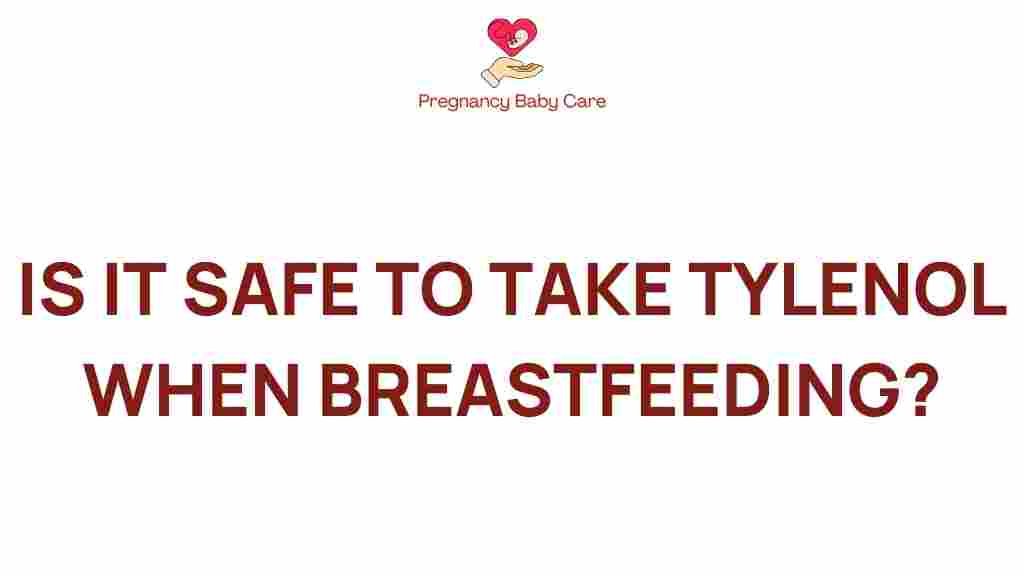The Safety of Tylenol During Breastfeeding: What You Need to Know
Breastfeeding is a crucial period in a mother and infant’s life, where maternal health directly influences infant health. As a nursing mother, you may experience various discomforts, leading you to consider medication for pain relief. One common medication that often comes to mind is Tylenol, known generically as acetaminophen. Understanding the safety of Tylenol during breastfeeding is vital for effective pain management without compromising your baby’s well-being. In this article, we will explore the implications of using Tylenol while breastfeeding, discussing medication safety, guidelines, and best practices for nursing mothers.
Understanding Tylenol and Its Uses
Tylenol, or acetaminophen, is a widely used over-the-counter medication commonly recommended for pain relief and fever reduction. It is favored due to its effectiveness and relatively low side effects compared to other pain relief medications. Typical uses of Tylenol include:
- Headaches
- Muscle aches
- Arthritis
- Toothaches
- Colds and fevers
For nursing mothers, managing pain effectively while ensuring infant safety is a top priority. The question arises: Is Tylenol safe to use during breastfeeding?
Medication Safety and Breastfeeding
The safety of medications during breastfeeding is a critical consideration. Many medications can pass into breast milk, potentially affecting the nursing infant. However, acetaminophen is generally considered safe for use during breastfeeding.
Research indicates that only a small amount of acetaminophen enters breast milk, usually less than 1% of the maternal dose. This minimal transfer suggests that Tylenol is unlikely to cause adverse effects in breastfed infants. Moreover, the American Academy of Pediatrics (AAP) classifies acetaminophen as compatible with breastfeeding.
Health Guidelines for Using Tylenol While Breastfeeding
When considering the use of Tylenol during breastfeeding, it is essential to follow some health guidelines to ensure both maternal and infant health:
- Consult Your Healthcare Provider: Always talk to your doctor or a lactation consultant before taking any medication, including Tylenol, to discuss your specific situation.
- Follow Recommended Dosages: Adhere strictly to the recommended dosage on the packaging or as advised by your healthcare provider. Overdosing can lead to severe health issues for both mother and baby.
- Timing of Medication: If possible, take Tylenol right after breastfeeding. This will allow more time for the medication to clear from your system before the next feeding.
- Monitor Your Infant: Keep an eye on your baby for any unusual symptoms after you take medication. If you notice changes in behavior, feeding patterns, or unusual fussiness, consult your healthcare provider.
Benefits of Tylenol for Nursing Mothers
The benefits of using Tylenol for nursing mothers include:
- Effective Pain Relief: Tylenol effectively alleviates pain, allowing mothers to care for their infants without discomfort.
- Minimal Side Effects: Compared to other pain relievers, acetaminophen has fewer gastrointestinal side effects, making it a preferred choice for many.
- Safe for Long-Term Use: For chronic pain management, Tylenol is often safe for longer durations when used as directed.
Alternatives to Tylenol for Pain Relief
While Tylenol is generally safe, there are other options for pain relief that nursing mothers may consider:
- Ibuprofen: Another over-the-counter pain reliever that is also safe during breastfeeding.
- Non-Pharmacological Options: Techniques such as heat therapy, gentle exercises, or relaxation methods can help manage pain without medication.
- Herbal Remedies: Some natural remedies may provide relief, but it’s crucial to consult with a healthcare provider before trying them.
Step-by-Step Process for Taking Tylenol While Breastfeeding
If you decide to take Tylenol while breastfeeding, follow these steps to ensure safety:
- Consult Your Healthcare Provider: Discuss your pain symptoms and confirm that Tylenol is appropriate for you.
- Understand Recommended Dosage: Familiarize yourself with the recommended dosage based on your age and health status.
- Take Tylenol After Feeding: Plan to take the medication right after breastfeeding to minimize any potential exposure to your baby.
- Monitor for Side Effects: Be aware of any unusual reactions in both yourself and your infant after taking the medication.
- Keep a Record: Maintain a log of when you take Tylenol and any observations about your infant’s behavior or health.
Troubleshooting Tips for Nursing Mothers
If you’re concerned about using Tylenol while breastfeeding, consider the following troubleshooting tips:
- Stay Informed: Keep yourself updated with the latest research on medication safety during breastfeeding.
- Communicate with Healthcare Providers: Regularly discuss your health and any changes with your doctor or lactation consultant.
- Alternative Pain Management: Explore holistic approaches to pain relief that do not involve medication.
- Watch for Signs: Be vigilant for any signs of discomfort or adverse reactions in your infant.
Conclusion
In conclusion, Tylenol is generally considered safe for nursing mothers to use for pain relief. With its minimal transfer into breast milk and endorsement from health guidelines, acetaminophen can be an effective solution for managing pain during the breastfeeding journey. However, it’s essential to consult with your healthcare provider, follow recommended dosages, and be attentive to both your health and your infant’s well-being.
By adhering to these guidelines and being proactive about your health, you can ensure that you remain comfortable and capable of caring for your little one. For more information on medication safety during breastfeeding, consider visiting the CDC’s breastfeeding resources or consult with a healthcare professional who specializes in maternal health.
Remember, your health is a priority, and making informed choices about medication will benefit both you and your baby.
This article is in the category Health and created by PregnancyBabyCare Team
